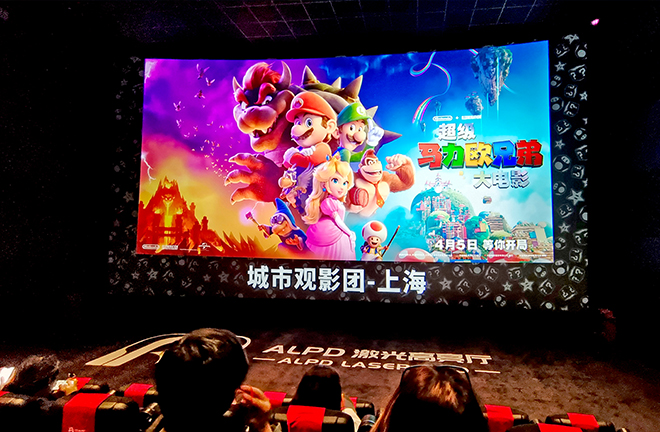Literary and artistic attributes of new media games

“Super Mario Bros. Movie,” the animated film based on Nintendo’s Mario video game franchise, premiered on April 5th, 2023. Photo: Chen Yuyu/CNSphoto
Today, new media games represented by large-scale online games are one of the most influential forms of entertainment. Games have also become a subject of literary and artistic research as they bear many similarities to literature, film and other art forms in terms of audio-visual experience, narrative techniques, and aesthetic emotions. More importantly, games are transforming literary and artistic creation in terms of approach, content, and future direction.
Interactive creation
With the deep integration of new media games into daily life, player interaction and game mechanics have gradually permeated popular culture through frequent exposure and a wide variety of game genres. Interactivity is not an essential element in literature and art, but it is an inherent and fundamental attribute of games. Audiences and creators of literary and artistic works have become accustomed to the interactivity of games over time, and reached a consensus on the exploration of interactivity.
The rise of virtual reality, augmented reality, and other technologies laid a solid foundation for the integration of new media games and film and television arts. Inspired by the interactivity of new media games, contemporary literature and art have incorporated the audiences into the creative process. The incorporation of multiple interactive nodes increases the volume of works, and each individual audience can select the content they desire. This can be regarded as a form of personalized literary and artistic creation that may considerably influence the aesthetic emotions of the audience for the same piece of work.
Once dominated by creators, literary and artistic creation is shifting towards co-creation by both creators and the audience in a highly interactive new media environment. While the choices made by the audience are predetermined and distributed by the creators according to their own logic, the audience’s engagement and interaction demonstrate their creative awareness.
Exchange of content
Recent advancements in computer and internet technologies have allowed new media games to progressively match, and in some cases surpass, films and novels in terms of characterization, narrative depth, plot intricacy, and visual representation. Meanwhile, new media games no longer rely solely on simple operations to attract users. They now strive to cater to the diverse aesthetic demands of users by looking for suitable content support from a vast array of literary and artistic themes and story archetypes. As a result, games, literature and art are becoming important sources of content for each other.
On the one hand, game developers search literary and artistic themes and stories for suitable characters and plots that can provide inspiration for the design of their own characters, levels, and rewards. For instance, many Chinese video games are based on classic Chinese novels such as Roman of the Three Kingdoms and Journey to the West, on wuxia novels (stories about martial arts chivalry) such as Demi-Gods and Semi-Devils, and on fantasy novels such as Journey of Flower. Inspiration drawn from classical literature and art endows games with more reasonable narrative logic, as well as character arcs and details that are likely to resonate with players.
On the other hand, literary and artistic creators select valuable characters and story archetypes from games, then enrich and reorganize those elements by means of literary and artistic techniques in order to create their own works. Games such as Tomb Raider, Resident Evil, Warcraft, Prince of Persia, and Assassin’s Creed have been adapted for film, and The Last of Us has been adapted for television.
The exchange of content between new media games and literature and art can provide games with more story archetypes and initial players, while also bringing innovative content and ideas to literary and artistic creation.
Future evolution
Prior to the integration of games into literary and artistic creation, creators sought to convey aesthetic values and philosophical reflections through their works. By offering unparalleled entertainment experiences, new media games hold irresistible allure for players who are no longer merely satisfied with emotional fulfillment and intellectual enlightenment. In this new context, literary and artistic works have shifted focus to offering pleasure and shaping future aesthetic experiences through game-like entertainment.
How creators and audiences perceive literature and art has implications for the direction of their future evolution. For digital natives who have grown up immersed in gaming culture, experiences and memories of games may last throughout their lives. These young creators and audiences are more likely to view literature and art from a gaming perspective, which could pose some risks.
Creators may disregard facts and arbitrarily alter the personality and life experiences of historical figures to increase entertainment value. Audiences may excessively prioritize the commercial value of literary and artistic works while overlooking artistic and aesthetic value. Serious literary and artistic inquiries could be ignored due to the gaming mindset of creators, audiences, and critics.
New media games affect the current approach towards and content of literary and artistic creation, as well as the direction of future literary and artistic evolution. We should therefore not only emphasize their economic and technological value, but also reflect upon their ontological value, thereby updating the angle of and approach to literary and artistic research.
Wang Chuanling is an associate professor in the School of Media and Technology at Liaocheng University.
Edited by WANG YOURAN
